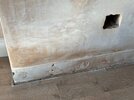I’m in the process of painting and decorating downstairs and have noticed this damp patch on the chimney breast. The wall used to be covered with wallpaper, and a few months ago, I stripped the wallpaper and had the wall re-skimmed.
Ever since I had the chimney breast re-skimmed, I’ve noticed this damp patch.
I assumed it was rising damp (the chimney has not been used for years), so I removed the skirting board, but was surprised to find it dry behind it.
I'm puzzled why it's damp above the skirting board section. The chimney is ventilated, but I'm not sure if water is seeping from the top of the chimney and making its way down to the hearth, It still does not explain why the base of the breast is not damp.
Any help, greatly appreciated.
Ever since I had the chimney breast re-skimmed, I’ve noticed this damp patch.
I assumed it was rising damp (the chimney has not been used for years), so I removed the skirting board, but was surprised to find it dry behind it.
I'm puzzled why it's damp above the skirting board section. The chimney is ventilated, but I'm not sure if water is seeping from the top of the chimney and making its way down to the hearth, It still does not explain why the base of the breast is not damp.
Any help, greatly appreciated.




